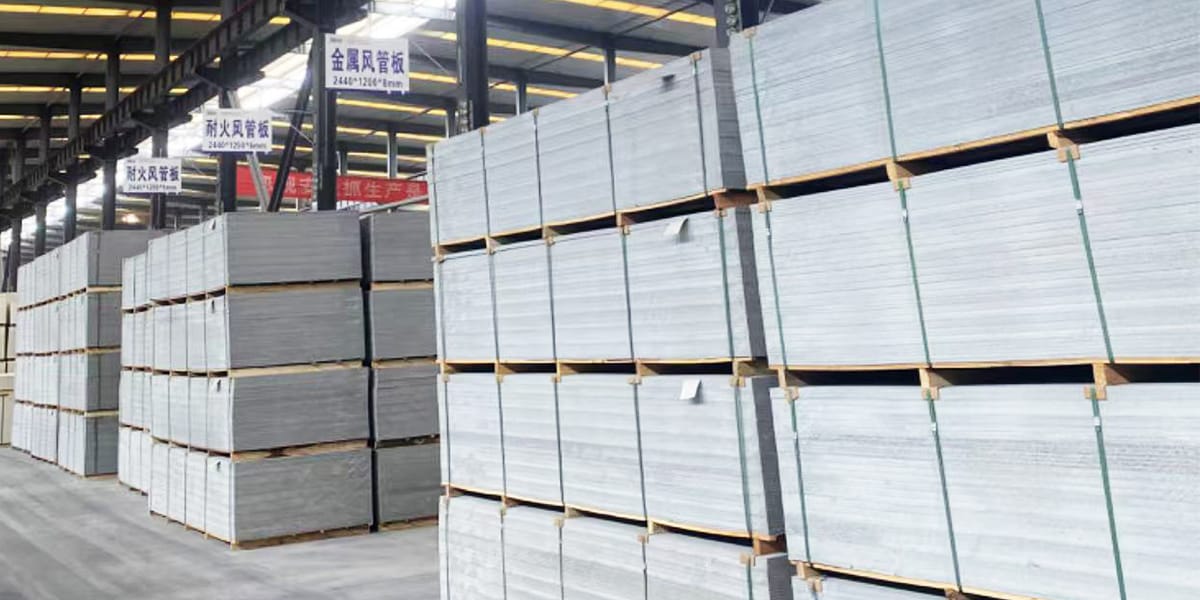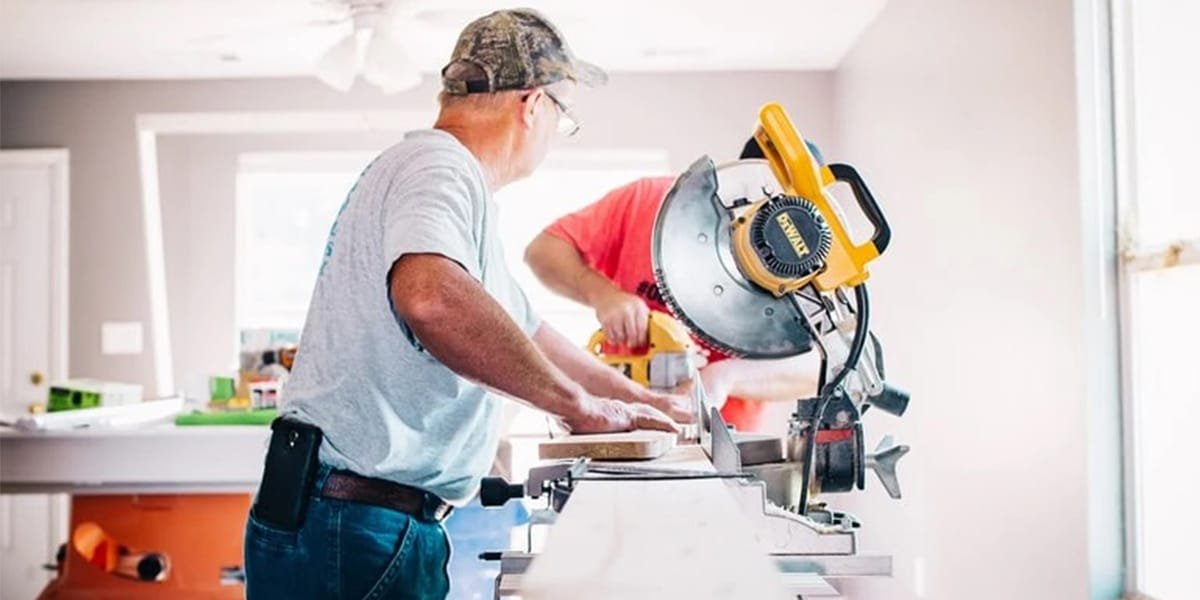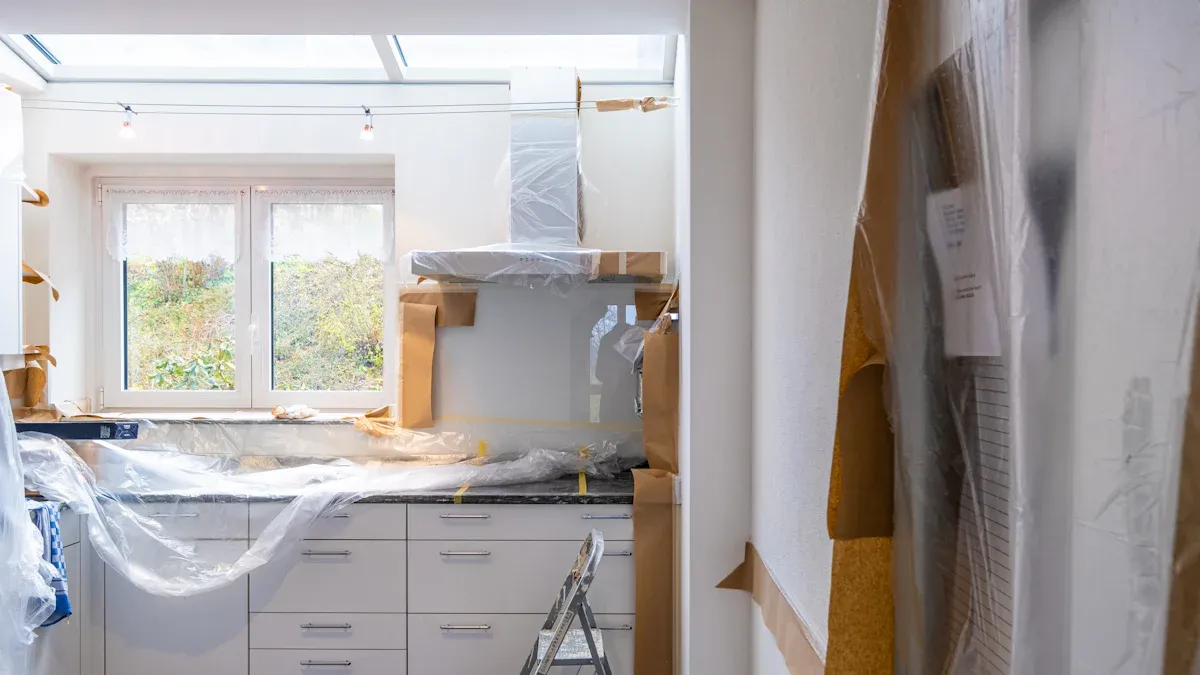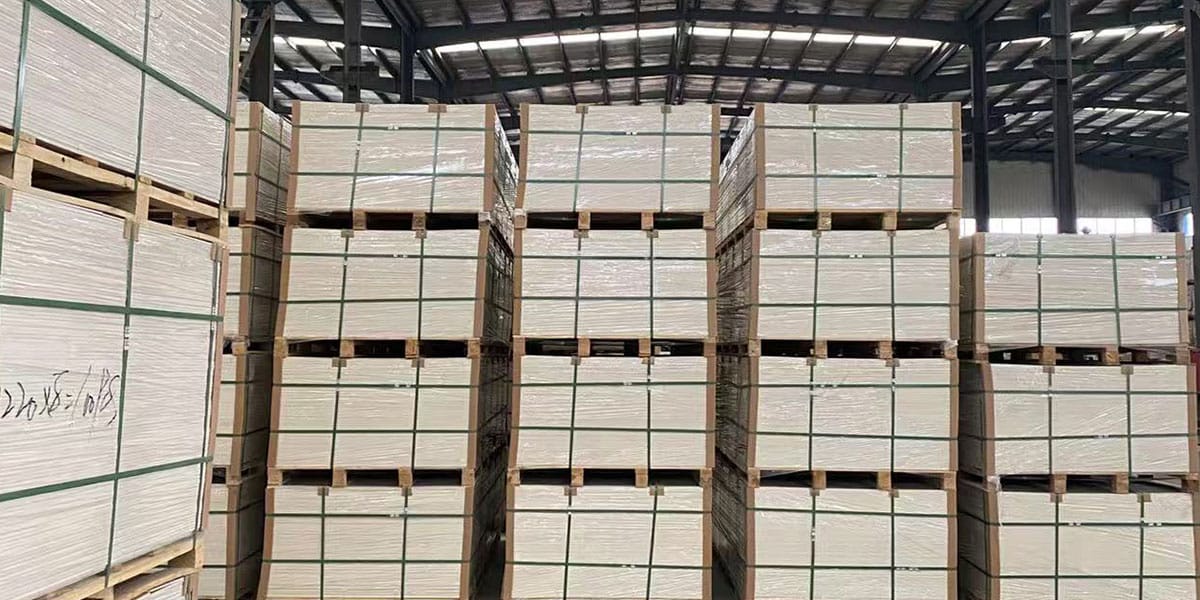
03 Jul Magnesium Oxide Board Guide for Homeowners and Contractors
Table of Contents
You want a building material that keeps your home safe and strong. Magnesium oxide boards protect against fire, mold, and water better than many old materials. The magnesium oxide board market is growing quickly because these boards stay tough in wet places like bathrooms and basements. Many homeowners and contractors pick them because they are good for the environment and not harmful. This magnesium oxide board guide helps you see why these boards work well in kitchens, stores, and places where fire safety is very important.
Key Takeaways
Magnesium oxide boards stop fire, water, and mold. They are strong and safe for homes and buildings.
These boards are good in wet places like bathrooms and basements. They do not swell or crack. Pick the right board thickness for your job. Use thin boards for ceilings. Use medium boards for walls. Use thick boards for floors or outside. Install them the right way. Cut with the right tools. Leave gaps so the boards can expand. Use screws that do not rust. Seal the joints well. Magnesium oxide boards cost more at first. But they save money later. They need fewer repairs. They last longer. They are better for the environment.
Magnesium Oxide Board Guide
What Is a Magnesium Oxide Board?
You might ask how a magnesium oxide board is different from other building materials. A magnesium oxide board, or mgo board, is made with magnesium oxide powder, magnesium chloride, perlite, and fiberglass mesh. These parts make the board strong, light, and able to last a long time. When you use a magnesium oxide board, it reacts with water and carbon dioxide. This reaction helps the board get stronger and more stable as time goes on.
Here is a simple table about the science and rules for mgo board:
Aspect | Details |
|---|---|
Composition | Magnesium oxide, magnesium chloride, perlite, fiberglass mesh |
Chemical Reactions | Hydration and carbonation increase strength and stability |
Fire Resistance | Meets ASTM E84 / UL 723, Grade A1; resists fire for 2-3 hours at 800ºC |
Water Resistance | Does not swell, crack, or degrade in wet conditions |
Thermal Insulation | High R-values for better energy efficiency |
Industry Standards | Complies with fire and durability tests for construction use |
Key Benefits
There are many good things about using magnesium oxide boards. These boards do not burn, so they help keep your home safe from fire. They also stop mold and mildew, which keeps your walls and ceilings clean. You can put mgo board in wet places like bathrooms or basements because it does not swell or fall apart. It is easy to install mgo board, and it does not let out harmful gases when it gets hot. This makes it safe for you and your family.
Tip: Magnesium oxide boards help you build in a way that is better for the environment and make the air inside cleaner.
Common Applications
Magnesium oxide boards can be used in many places. The magnesium oxide board guide says thin mgo board is good for ceilings and walls. Boards that are a bit thicker work for doors, kitchen panels, and furniture. Most people use magnesium oxide board for green homes, fire-safe houses, and fixing up old buildings. Contractors often use mgo board for big buildings that need to be strong and safe from fire.
Segment Type | Common Applications |
|---|---|
Thin (<8 mm) Boards | Ceiling linings, walls, fascia |
Medium (8-15 mm) Boards | Doors, kitchen panels, furniture |
Residential Buildings | Green homes, partitions, ceilings, subflooring |
Industrial Buildings | Fireproof, durable, sustainable construction |
The magnesium oxide board guide helps you pick the right mgo board for your project, whether you are building something new or making an old space better.
MgO Board Selection
 Thickness and Types
Thickness and Types
When you choose a magnesium oxide board, you need to think about thickness and type. Each mgo board comes in different thicknesses, usually from 6 mm to 20 mm. Thin boards work well for ceilings and wall linings. Thicker boards give you more strength for floors, subflooring, or exterior walls. You can also find mgo board types made for special uses, like decorative panels or structural insulated panels (SIPs). Some boards have extra layers for soundproofing or extra fire resistance.
Thickness (mm) | Common Use |
|---|---|
6-8 | Ceilings, wall linings |
10-12 | Partitions, panels |
15-20 | Subflooring, exterior |
Tip: Always check the label to see if the magnesium oxide board matches your project’s needs.
Matching to Project
You want the right mgo board for your job. Sulfycor and other design guides show you how to match magnesium oxide board types to your project. For example, you can use thin boards for ceilings, but you need thicker boards for floors or walls that need to hold weight. Modular wall panels work well in homes, offices, and hospitals. You can also pick a magnesium oxide board for fire resistance, eco-friendliness, or fast installation. Many guides offer FAQs and expert help, so you can find the best mgo board for your space.
- Use thin magnesium oxide board for ceilings and decorative walls.
- Choose medium mgo board for partitions and kitchen panels.
- Pick thick magnesium oxide board for subfloors and exterior walls.
- Ask for help if you have a special project or need extra strength.
Cost Factors
You may notice that a magnesium oxide board costs more at first than plywood or drywall. The mgo board gives you better fire and moisture resistance, so you save money on repairs over time. Plywood can swell or warp when wet, but a magnesium oxide board stays strong. You also get better sound insulation and a longer lifespan. The mgo board is heavier, so you might spend more on labor. Still, you get fewer repairs and less maintenance. If you want a green building, a magnesium oxide board helps you reach eco-friendly goals and may even increase your property value.
- Higher upfront cost for mgo board, but lower long-term repair bills.
- Less maintenance because magnesium oxide board resists water, fire, and mold.
- Eco-friendly mgo board can help with green building certifications.
- Installation may cost more due to weight and supply.
Installation Steps
 You need to plan carefully before installing magnesium oxide board. Pay attention to details for a good result. Follow these steps and use the right tools and materials. This section will help you from start to finish.
You need to plan carefully before installing magnesium oxide board. Pay attention to details for a good result. Follow these steps and use the right tools and materials. This section will help you from start to finish.
Tools and Materials
Get all your tools and materials before you begin. The right equipment keeps you safe and helps you work faster. Here is a table to help you get ready:
Tool/Material | Purpose/Use Description |
|---|---|
Carbide-tipped scoring knife | Cutting magnesium oxide board |
Dust-reducing circular saw | Cuts boards while minimizing dust |
Fiber cement shears | Precise and accurate cuts |
Corrosion-resistant screws | Securely fasten boards and resist rust |
Adhesive | Bonds boards to surfaces |
Polyurea or epoxy seam filler | Fills gaps between boards for smooth joints |
Underlayment | Provides a stable base for installation |
You also need safety gear. Wear safety glasses, a dust mask, and gloves. These protect you from dust and sharp edges. Keep your workspace clean and tidy.
Tip: Check your tools and materials before you start. This helps you avoid delays and keeps your project moving.
Surface Preparation
Getting the area ready is very important. Clean the surface well. Remove dust, dirt, and loose pieces. Use a broom or vacuum for best results. Make sure the subfloor or wall is flat, dry, and strong. Fix any cracks or damage before you start.
Check the moisture level of the surface. Wood should be between 2-4%. Concrete should be under 75%. This stops future problems with moisture and mold. If you skip this step, the board may not stick well or last long.
Note: Good preparation helps you avoid expensive repairs later.
Cutting and Gaps
Cutting magnesium oxide board needs care and the right tools. Use a carbide-tipped scoring knife for thin boards. Score the board deeply, then snap it. For thick boards, use a dust-reducing circular saw or fiber cement shears. Always measure and mark before cutting. This makes sure your cuts fit and you waste less.
Leave a 1/8 inch gap between each board. This lets the boards expand and shrink. Fill these spaces with a flexible, fire-rated seam filler. For wood frames, keep gaps at 1/8 inch. For steel frames, keep gaps at 1/16 inch. This stops stress and cracking when temperatures change.
Tip: Cut boards outside or in a place with fresh air. This keeps dust away from you.
Fastening
Use corrosion-resistant screws like stainless steel or galvanized screws. These stop rust and hold the board tight. Drill small holes first to stop the board from cracking. Put screws 12 inches apart on the edges and 16 inches apart in the center for walls. For floors, put screws every 150–200mm.
Make screws level with the board, but do not make them too tight. Keep screws at least 12mm from the edges and 50mm from the corners. This keeps the board safe from damage. For extra strength, use construction adhesive on the back before screwing.
Remember: Always follow local rules and building codes for safety. Seal all holes and joints with fire-resistant sealants.
Joint Sealing
Treating joints the right way makes your project last longer. Leave a 1/8 inch gap between sheets for movement. Fill the gap with a flexible filler like Manus-Bond 75-AM. Put 6-inch fiberglass tape into a compound like RapidSet “Wunderfixx” to make the seam stronger. Sand the area lightly while it is still damp for a smooth finish.
Add a final coat with products like Murco Wall M-100 or Westpac Materials “Red Dot.” This makes the surface look smooth and ready for paint or texture. Keep the temperature and humidity steady during this step. This stops tiny cracks from forming.
Tip: Sealing joints keeps out moisture and fire. It also makes your project look neat and finished.
Finishing Touches
The last step is finishing the board. Sand the surface to remove rough spots. Clean off dust and dirt. Pick the right primer for magnesium oxide board. Use primers made for concrete or masonry because they work with the board’s chemistry.
Spread primer evenly over the surface. This helps paint or other finishes stick better. After priming, you can paint or use acrylic stucco topcoats. Test paint by making a small X cut, putting tape on it, and checking if the paint stays. This makes sure your finish lasts.
Keep the boards in the room for 3-5 days before finishing. Run the HVAC system for at least 72 hours before and after installation. This helps stop tiny cracks and keeps the finish strong.
Note: Finishing steps like priming and painting protect your board and make it look nice. If you want the best result, you can hire an expert.
If you follow these steps and tips, your project will be strong, safe, and look great. If your project is hard or you need help, experts can make sure your installation meets all the rules.
Troubleshooting
Handling and Storage
You want to keep your magnesium oxide boards in good shape before you install them. Store the boards flat on a strong, level surface. This prevents bending or warping. Always protect the boards from water by using covers, membranes, or an exterior rendering system. Carry each board upright with two people to avoid cracks or breaks. Use carbide tools, such as circular saws, for smooth cuts. Wear a dust mask or use a vacuum system when cutting to protect your lungs. Choose corrosion-resistant screws because the chloride in the boards can damage regular metal fasteners. Avoid soft galvanized screws unless you use a special barrier coating. Test adhesives like moisture-cure urethanes before using them for your project.
Tip: Good storage and careful handling help you avoid costly repairs and keep your boards strong.
Preventing Cracks
Cracks can form if you do not follow the right steps. Always leave a small gap between boards to allow for movement. Use an exterior rendering system to seal and protect the surface. Make sure you support the ends of each board during installation. Do not over-tighten screws, and keep them away from the edges. If you see a crack, use the correct treatment right away. Sand the area, clean it, and then apply joint compound to fill the gap. Let it dry before you finish the surface. This process keeps your walls and ceilings smooth and strong.
Moisture and Mold Issues
Moisture can cause big problems if you do not take care. Magnesium oxide boards resist water, but you still need to protect them. Use an exterior rendering system to keep out rain and humidity. Seal all edges and joints with mold-resistant adhesives. Make sure the room has good airflow and keep indoor humidity below 50%. Regularly check for signs of moisture or mold. Clean any spots with a mold-fighting solution. Studies show that magnesium oxide boards do not feed mold, but trapped moisture can still cause trouble. The right treatment and maintenance keep your boards healthy and your air clean.
- Prepare a dry, clean surface before installing.
- Seal all edges and avoid direct ground contact.
- Use an exterior rendering system for extra protection.
Repair Tips
If you find damage, act fast. Small chips or cracks need simple treatment. Sand the area, clean away dust, and use an exterior rendering system to patch the spot. For deeper cracks, fill them with a flexible filler and then apply joint compound. Let it dry, sand it smooth, and repaint or refinish as needed. Always check for moisture before you repair. If you see signs of water damage, fix the source first. Regular inspections and quick repairs help your magnesium oxide boards last longer.
Note: A strong exterior rendering system protects your boards from weather and keeps repairs simple.
Magnesium Oxide Boards vs. Traditional Materials

Drywall Comparison
Magnesium oxide boards and drywall are very different. Magnesium oxide boards do not burn. They can handle very high heat. Drywall can resist fire a little, but not as well. Magnesium oxide boards are also stronger than drywall. They do not break easily and stay strong in wet places. Drywall can crack or get ruined if it gets wet. Mold and mildew can grow on drywall because it is not antimicrobial.
Here is a table that shows how they are different:
Aspect | Magnesium Oxide Boards | Drywall (Gypsum Board) |
|---|---|---|
Fire Resistance | Non-combustible; withstands high heat | Some fire resistance; lower performance |
Durability | Strong, impact and moisture resistant | Less durable; not moisture resistant |
Mold Resistance | Antimicrobial; mold and mildew resistant | No antimicrobial properties |
Tip: Magnesium oxide boards are safe for your health. They are non-toxic, good for the planet, and can be recycled.
Plywood Comparison
Magnesium oxide boards are much better with water than plywood. Plywood soaks up water and gets weak. It can even rot or grow mold in damp places. Magnesium oxide boards do not change shape or lose strength when wet. They also do not get damaged by freezing and thawing like plywood does. You can use magnesium oxide boards where you need something that does not mind water.
Look at this table to compare them:
Property / Aspect | Magnesium Oxide Boards | Plywood (Wood-based Boards) |
|---|---|---|
Bending Strength | High; keeps strength when wet | Lower; loses strength with moisture |
Water Absorption | Moisture resistant; keeps integrity | Absorbs water; can degrade |
Mold and Rot Resistance | Mold, mildew, and rot resistant | Prone to mold and rot |
Freeze-Thaw Durability | Good durability | Prone to damage |
Note: Some magnesium oxide boards may not work well with some chemicals. Most are still better with water than plywood.
Pros and Cons
Magnesium oxide boards have many good points. They do not burn, and they do not get ruined by water. Mold and mildew cannot grow on them. You can use them in bathrooms, kitchens, and basements. They last longer than drywall or plywood. They are also safe for the earth because you can recycle them and they are not toxic.
There are a few things to think about. Magnesium oxide boards cost more at first. They are heavier, so you might need help to put them in. Some types need special screws or coatings to stop rust.
Pros:
- Fireproof and moisture resistant
- Mold and mildew resistant
- Durable and impact resistant
- Eco-friendly and recyclable
Cons:
- Higher upfront cost
- Heavier than drywall or plywood
- May need special installation steps
If you want something strong, safe, and good with water, magnesium oxide boards are a great pick for your project.
Maintenance
Cleaning
You can keep magnesium oxide boards looking new with simple cleaning steps. Use a soft brush or vacuum to remove dust and dirt from the surface. For stains, wipe the board with a damp cloth and mild soap. Avoid harsh chemicals or abrasive pads. These can scratch or damage the board. If you see mold or mildew, clean the area with a solution of water and vinegar. Rinse with clean water and dry the surface with a towel. Regular cleaning helps your boards stay bright and healthy.
Tip: Always test any cleaning product on a small, hidden area first.
Repairs
You may notice small chips or cracks over time. Fix these quickly to keep your boards strong. For minor damage, sand the area gently and wipe away dust. Fill the spot with a patching compound made for MgO boards. Let it dry, then sand it smooth. For larger cracks, use a flexible filler before applying joint compound. Always check for moisture before you repair. If you find water damage, fix the leak first. After repairs, repaint or refinish the area to match the rest of the board.
Common repair steps:
Sand and clean the damaged area.
Apply patching compound or flexible filler.
Let it dry and sand smooth.
Repaint or refinish as needed.
Longevity
Magnesium oxide boards last a long time when you care for them. You get strong protection against cracking, swelling, and water damage. These boards resist fire for up to three hours and can handle heat up to 800ºC. You do not need to worry about mold or mildew because the boards do not absorb moisture. Their dense build lets them bend without breaking, which adds to their lifespan.
- Hospitals report about 22% lower repair costs when using MgO boards.
- Buildings with MgO boards often see lower insurance costs and higher property values.
- Schools, offices, and homes use MgO boards for safety and durability in humid or fire-prone areas.
- Certifications and tests show MgO boards meet strict fire and sustainability standards.
You can trust MgO boards to protect your space for many years. Regular care and quick repairs help you get the most from this strong, safe material.
Magnesium oxide boards give you strong fire, water, and mold resistance. You help the planet by choosing a material that supports green building and better air quality.
- You see more builders using MgO boards in homes, schools, and offices.
- These boards last longer and need less repair.
- Market growth shows rising demand for safe, eco-friendly materials.
Take the next step. Use this guide to select and install MgO boards. You gain peace of mind and add lasting value to your space.
FAQ
How do you cut magnesium oxide boards safely?
Use a carbide-tipped scoring knife for thin boards. For thick boards, use a dust-reducing circular saw. Always wear safety glasses and a dust mask. Cut boards outside or in a well-ventilated area to keep dust away from your lungs.
Can you paint or tile over magnesium oxide boards?
Yes, you can paint or tile over these boards. Apply a primer made for masonry before painting. For tile, use a suitable adhesive. Always clean and sand the surface first for the best results.
Are magnesium oxide boards safe for people with allergies?
Magnesium oxide boards do not release harmful gases or dust after installation. They resist mold and mildew. You get cleaner indoor air, which helps people with allergies or asthma.
What is the best way to store unused boards?
Store boards flat on a dry, level surface. Keep them covered to protect from moisture. Avoid stacking heavy items on top. Carry boards upright with two people to prevent cracks.
Do magnesium oxide boards work outdoors?
You can use these boards outdoors if you seal all edges and joints. Use an exterior rendering system for extra protection. Always follow the manufacturer’s instructions for outdoor projects.

 Thickness and Types
Thickness and Types